Keyword
DSM
19 record(s)
Provided by
Type of resources
Topics
Keywords
Contact for the resource
Update frequencies
-
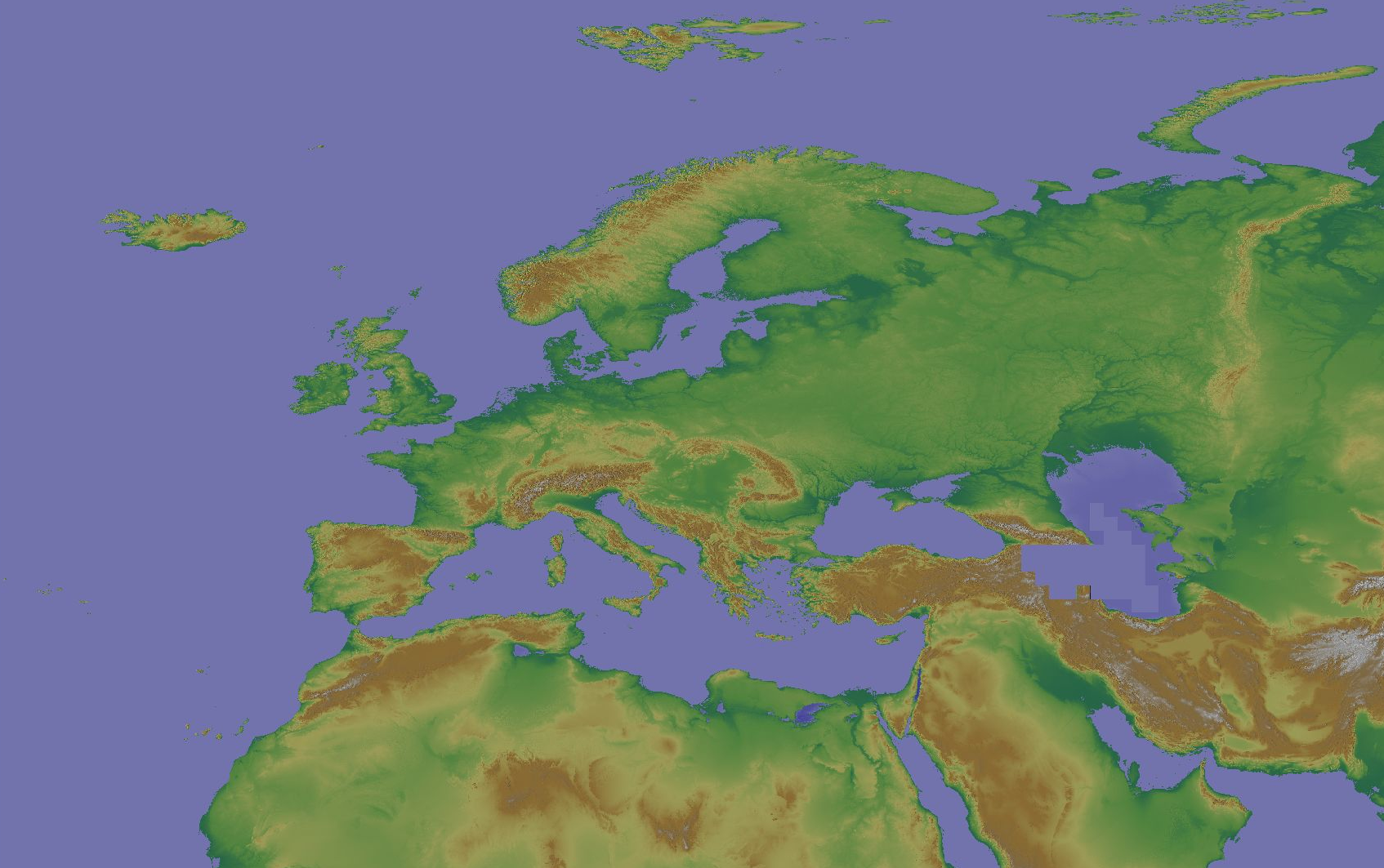
The Copernicus DEM is a Digital Surface Model (DSM) which represents the surface of the Earth including buildings, infrastructure and vegetation. The original GLO-30 provides worldwide coverage at 30 meters (refers to 10 arc seconds). Note that ocean areas do not have tiles, there one can assume height values equal to zero. Data is provided as Cloud Optimized GeoTIFFs. Note that the vertical unit for measurement of elevation height is meters. The Copernicus DEM for Europe at 30 arcsec (0:00:30 = 0.0083333333 ~ 1000 meter) in COG format has been derived from the Copernicus DEM GLO-30, mirrored on Open Data on AWS, dataset managed by Sinergise (https://registry.opendata.aws/copernicus-dem/). Processing steps: The original Copernicus GLO-30 DEM contains a relevant percentage of tiles with non-square pixels. We created a mosaic map in a https://gdal.org/drivers/raster/vrt.html format and defined within the VRT file the rule to apply cubic resampling while reading the data, i.e. importing them into GRASS GIS for further processing. We chose cubic instead of bilinear resampling since the height-width ratio of non-square pixels is up to 1:5. Hence, artefacts between adjacent tiles in rugged terrain could be minimized: gdalbuildvrt -input_file_list list_geotiffs_MOOD.csv -r cubic -tr 0.000277777777777778 0.000277777777777778 Copernicus_DSM_30m_MOOD.vrt In order to reduce the spatial resolution to 30 arc seconds, weighted resampling was performed in GRASS GIS (using r.resamp.stats) and the pixel values were scaled with 1000 (storing the pixels as integer values) for data volume reduction. In addition, a hillshade raster map was derived from the resampled elevation map (using r.relief, GRASS GIS). Eventually, we exported the elevation and hillshade raster maps in Cloud Optimized GeoTIFF (COG) format, along with SLD and QML style files.
-
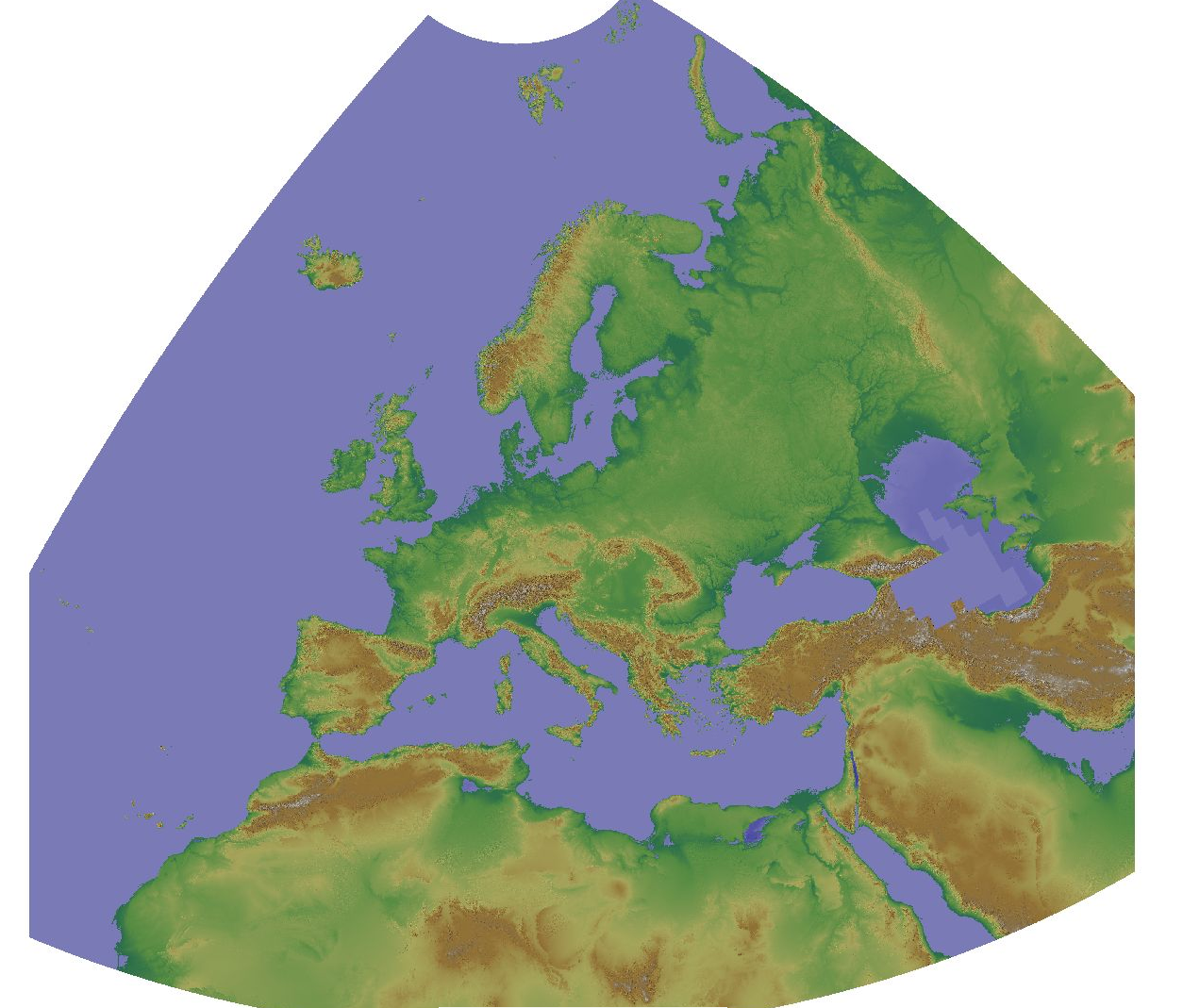
The Copernicus DEM is a Digital Surface Model (DSM) which represents the surface of the Earth including buildings, infrastructure and vegetation. The original GLO-30 provides worldwide coverage at 30 meters (refers to 10 arc seconds). Note that ocean areas do not have tiles, there one can assume height values equal to zero. Data is provided as Cloud Optimized GeoTIFFs. Note that the vertical unit for measurement of elevation height is meters. The Copernicus DEM for Europe at 100 meter resolution (EU-LAEA projection) in COG format has been derived from the Copernicus DEM GLO-30, mirrored on Open Data on AWS, dataset managed by Sinergise (https://registry.opendata.aws/copernicus-dem/). Processing steps: The original Copernicus GLO-30 DEM contains a relevant percentage of tiles with non-square pixels. We created a mosaic map in https://gdal.org/drivers/raster/vrt.html format and defined within the VRT file the rule to apply cubic resampling while reading the data, i.e. importing them into GRASS GIS for further processing. We chose cubic instead of bilinear resampling since the height-width ratio of non-square pixels is up to 1:5. Hence, artefacts between adjacent tiles in rugged terrain could be minimized: gdalbuildvrt -input_file_list list_geotiffs_MOOD.csv -r cubic -tr 0.000277777777777778 0.000277777777777778 Copernicus_DSM_30m_MOOD.vrt In order to reproject the data to EU-LAEA projection while reducing the spatial resolution to 100 m, bilinear resampling was performed in GRASS GIS (using r.proj) and the pixel values were scaled with 1000 (storing the pixels as Integer values) for data volume reduction. In addition, a hillshade raster map was derived from the resampled elevation map (using r.relief GRASS GIS). Eventually, we exported the elevation and hillshade raster maps in Cloud Optimized GeoTIFF (COG) format, along with SLD and QML style files.
-
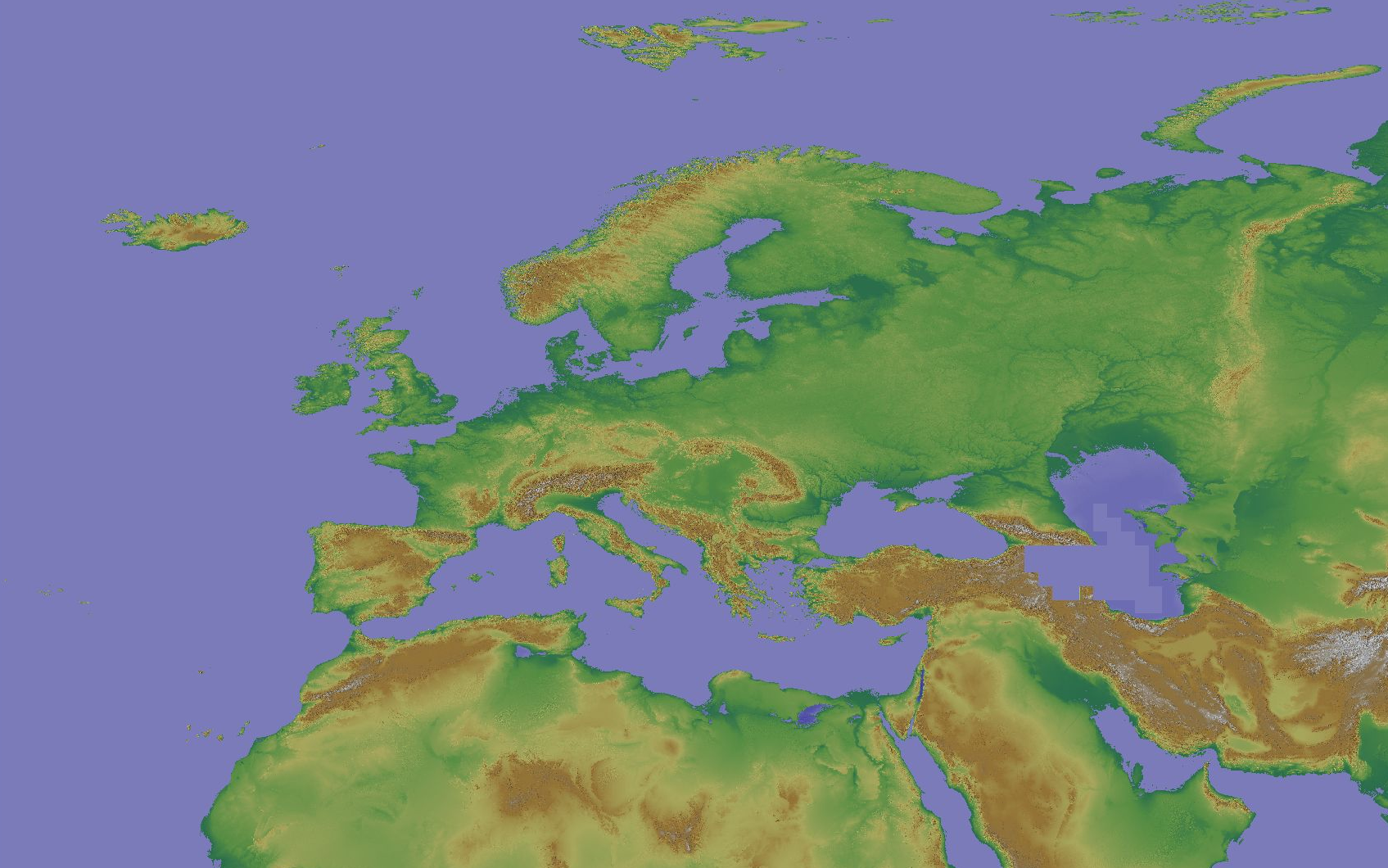
The Copernicus DEM is a Digital Surface Model (DSM) which represents the surface of the Earth including buildings, infrastructure and vegetation. The original GLO-30 provides worldwide coverage at 30 meters (refers to 10 arc seconds). Note that ocean areas do not have tiles, there one can assume height values equal to zero. Data is provided as Cloud Optimized GeoTIFFs. Note that the vertical unit for measurement of elevation height is meters. The Copernicus DEM for Europe at 3 arcsec (0:00:03 = 0.00083333333 ~ 90 meter) in COG format has been derived from the Copernicus DEM GLO-30, mirrored on Open Data on AWS, dataset managed by Sinergise (https://registry.opendata.aws/copernicus-dem/). Processing steps: The original Copernicus GLO-30 DEM contains a relevant percentage of tiles with non-square pixels. We created a mosaic map in https://gdal.org/drivers/raster/vrt.html format and defined within the VRT file the rule to apply cubic resampling while reading the data, i.e. importing them into GRASS GIS for further processing. We chose cubic instead of bilinear resampling since the height-width ratio of non-square pixels is up to 1:5. Hence, artefacts between adjacent tiles in rugged terrain could be minimized: gdalbuildvrt -input_file_list list_geotiffs_MOOD.csv -r cubic -tr 0.000277777777777778 0.000277777777777778 Copernicus_DSM_30m_MOOD.vrt In order to reduce the spatial resolution to 3 arc seconds, weighted resampling was performed in GRASS GIS (using r.resamp.stats -w) and the pixel values were scaled with 1000 (storing the pixels as integer values) for data volume reduction. In addition, a hillshade raster map was derived from the resampled elevation map (using r.relief, GRASS GIS). Eventually, we exported the elevation and hillshade raster maps in Cloud Optimized GeoTIFF (COG) format, along with SLD and QML style files.
-
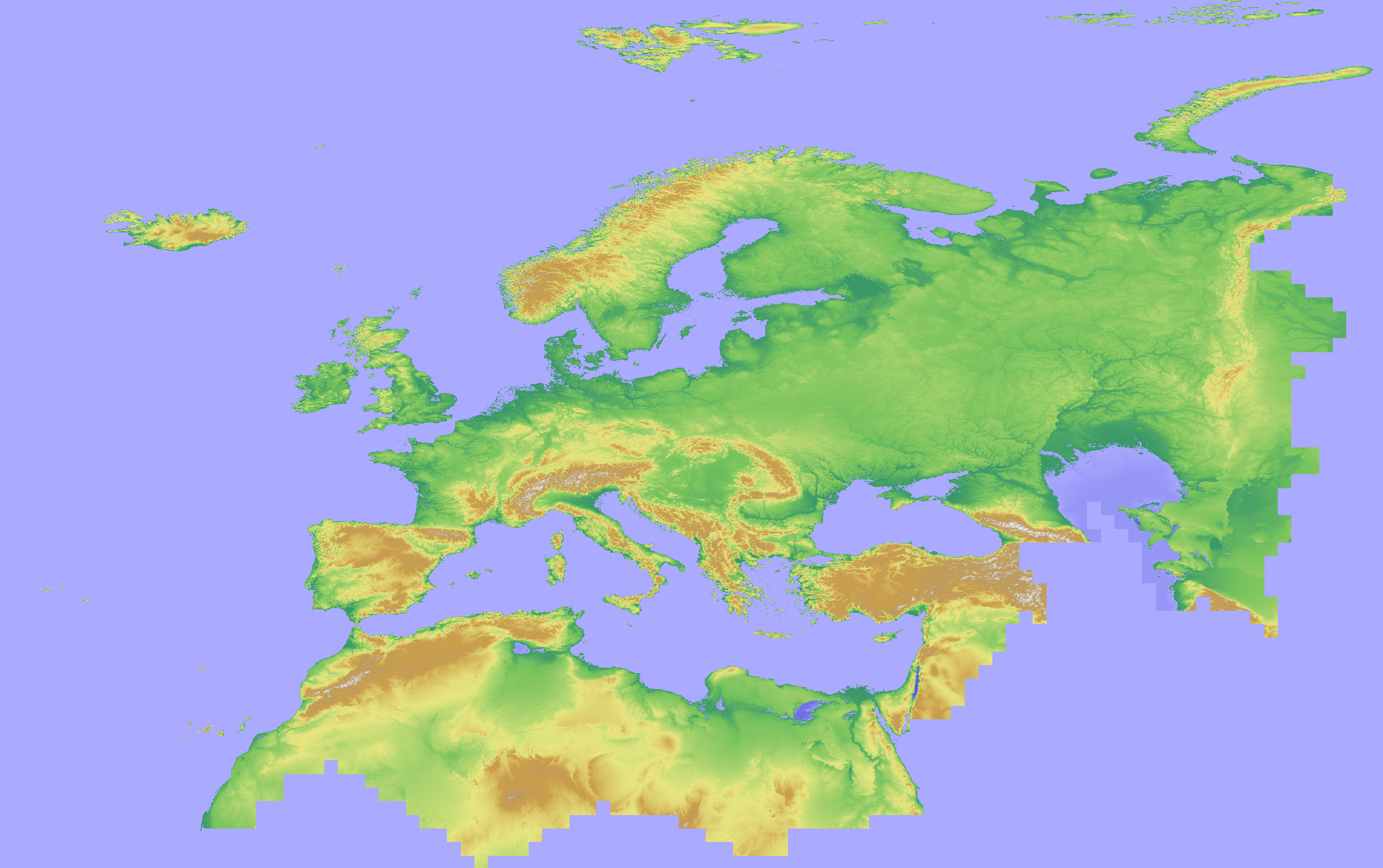
Here we provide a mosaic of the Copernicus DEM 30m for Europe and the corresponding hillshade derived from the GLO-30 public instance of the Copernicus DEM. The CRS is the same as the original Copernicus DEM CRS: EPSG:4326. Note that GLO-30 Public provides limited coverage at 30 meters because a small subset of tiles covering specific countries are not yet released to the public by the Copernicus Programme. Note that ocean areas do not have tiles, there one can assume height values equal to zero. Data is provided as Cloud Optimized GeoTIFFs. The Copernicus DEM is a Digital Surface Model (DSM) which represents the surface of the Earth including buildings, infrastructure and vegetation. The original GLO-30 provides worldwide coverage at 30 meters (refers to 10 arc seconds). Note that ocean areas do not have tiles, there one can assume height values equal to zero. Data is provided as Cloud Optimized GeoTIFFs. Note that the vertical unit for measurement of elevation height is meters. The Copernicus DEM for Europe at 30 m in COG format has been derived from the Copernicus DEM GLO-30, mirrored on Open Data on AWS, dataset managed by Sinergise (https://registry.opendata.aws/copernicus-dem/). Processing steps: The original Copernicus GLO-30 DEM contains a relevant percentage of tiles with non-square pixels. We created a mosaic map in https://gdal.org/drivers/raster/vrt.html format and defined within the VRT file the rule to apply cubic resampling while reading the data, i.e. importing them into GRASS GIS for further processing. We chose cubic instead of bilinear resampling since the height-width ratio of non-square pixels is up to 1:5. Hence, artefacts between adjacent tiles in rugged terrain could be minimized: gdalbuildvrt -input_file_list list_geotiffs_MOOD.csv -r cubic -tr 0.000277777777777778 0.000277777777777778 Copernicus_DSM_30m_MOOD.vrt The pixel values were scaled with 1000 (storing the pixels as integer values) for data volume reduction. In addition, a hillshade raster map was derived from the resampled elevation map (using r.relief, GRASS GIS). Eventually, we exported the elevation and hillshade raster maps in Cloud Optimized GeoTIFF (COG) format, along with SLD and QML style files.
-
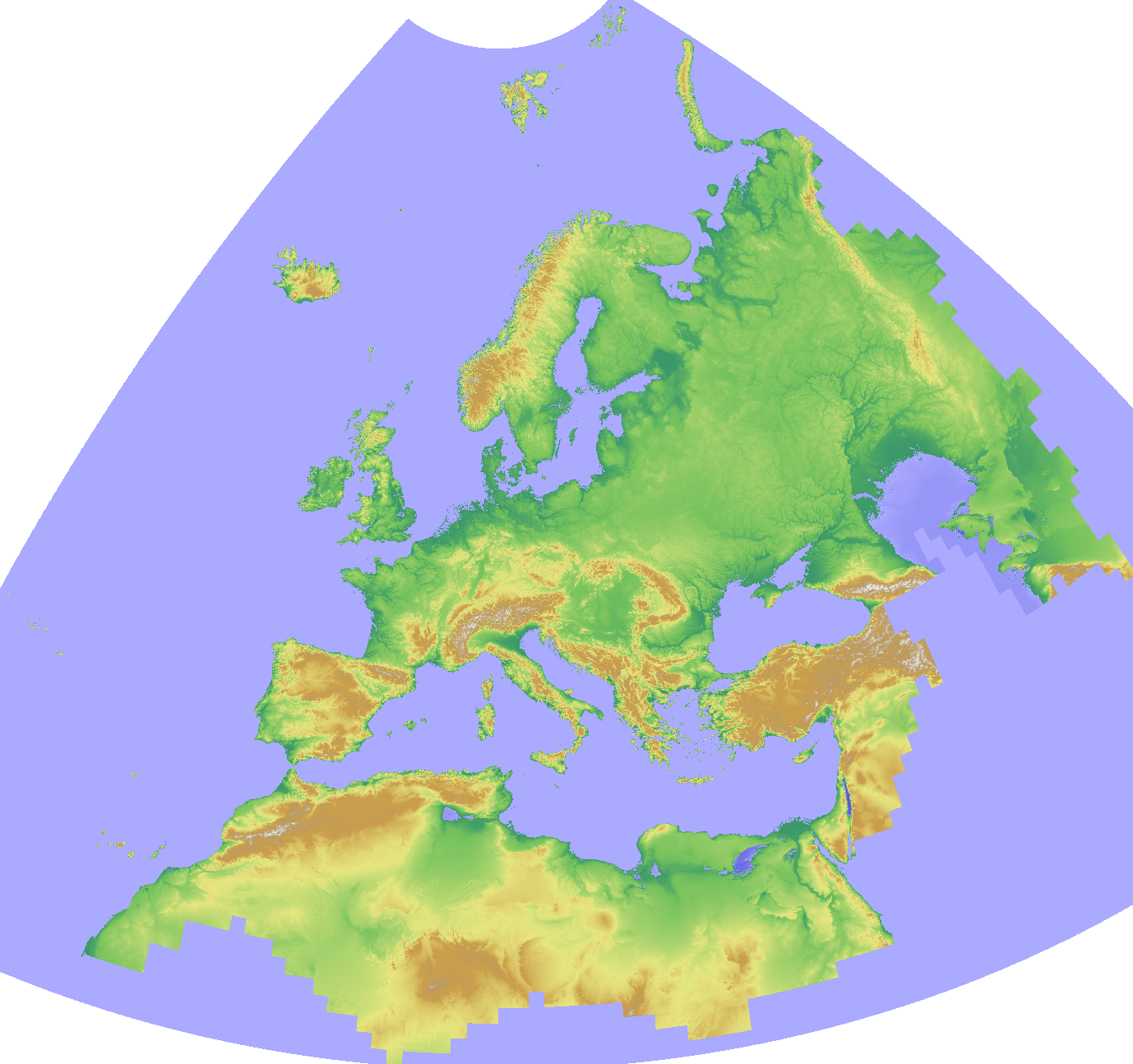
The Copernicus DEM is a Digital Surface Model (DSM) which represents the surface of the Earth including buildings, infrastructure and vegetation. The original GLO-30 provides worldwide coverage at 30 meters (refers to 10 arc seconds). Note that ocean areas do not have tiles, there one can assume height values equal to zero. Data is provided as Cloud Optimized GeoTIFFs. Note that the vertical unit for measurement of elevation height is meters. The Copernicus DEM for Europe at 30 meter resolution (EU-LAEA projection) in COG format has been derived from the Copernicus DEM GLO-30, mirrored on Open Data on AWS, dataset managed by Sinergise (https://registry.opendata.aws/copernicus-dem/). Processing steps: The original Copernicus GLO-30 DEM contains a relevant percentage of tiles with non-square pixels. We created a mosaic map in https://gdal.org/drivers/raster/vrt.html format and defined within the VRT file the rule to apply cubic resampling while reading the data, i.e. importing them into GRASS GIS for further processing. We chose cubic instead of bilinear resampling since the height-width ratio of non-square pixels is up to 1:5. Hence, artefacts between adjacent tiles in rugged terrain could be minimized: gdalbuildvrt -input_file_list list_geotiffs_MOOD.csv -r cubic -tr 0.000277777777777778 0.000277777777777778 Copernicus_DSM_30m_MOOD.vrt In order to reproject the data to EU-LAEA projection, bilinear resampling was performed in GRASS GIS (using r.proj) and the pixel values were scaled with 1000 (storing the pixels as Integer values) for data volume reduction. In addition, a hillshade raster map was derived from the resampled elevation map (using r.relief, GRASS GIS). Eventually, we exported the elevation and hillshade raster maps in Cloud Optimized GeoTIFF (COG) format, along with SLD and QML style files. Note that GLO-30 Public provides limited coverage at 30 meters because a small subset of tiles covering specific countries are not yet released to the public by the Copernicus Programme. Note that ocean areas do not have tiles, there one can assume height values equal to zero. Data is provided as Cloud Optimized GeoTIFFs.
-
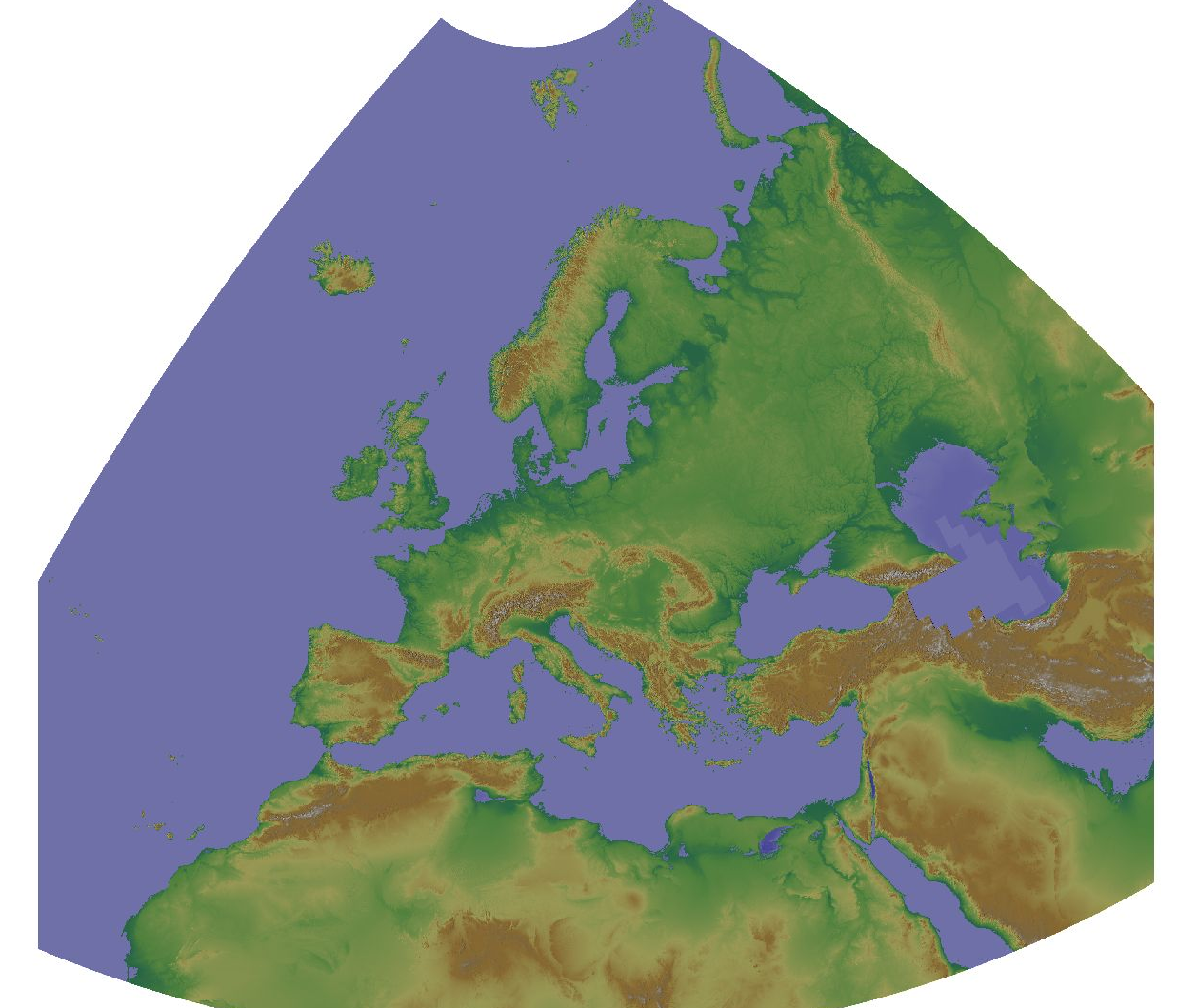
The Copernicus DEM is a Digital Surface Model (DSM) which represents the surface of the Earth including buildings, infrastructure and vegetation. The original GLO-30 provides worldwide coverage at 30 meters (refers to 10 arc seconds). Note that ocean areas do not have tiles, there one can assume height values equal to zero. Data is provided as Cloud Optimized GeoTIFFs. Note that the vertical unit for measurement of elevation height is meters. The Copernicus DEM for Europe at 1000 meter resolution (EU-LAEA projection) in COG format has been derived from the Copernicus DEM GLO-30, mirrored on Open Data on AWS, dataset managed by Sinergise (https://registry.opendata.aws/copernicus-dem/). Processing steps: The original Copernicus GLO-30 DEM contains a relevant percentage of tiles with non-square pixels. We created a mosaic map in https://gdal.org/drivers/raster/vrt.html format and defined within the VRT file the rule to apply cubic resampling while reading the data, i.e. importing them into GRASS GIS for further processing. We chose cubic instead of bilinear resampling since the height-width ratio of non-square pixels is up to 1:5. Hence, artefacts between adjacent tiles in rugged terrain could be minimized: gdalbuildvrt -input_file_list list_geotiffs_MOOD.csv -r cubic -tr 0.000277777777777778 0.000277777777777778 Copernicus_DSM_30m_MOOD.vrt In order to reproject the data to EU-LAEA projection while reducing the spatial resolution to 1000 m, bilinear resampling was performed in GRASS GIS (using r.proj) and the pixel values were scaled with 1000 (storing the pixels as Integer values) for data volume reduction. In addition, a hillshade raster map was derived from the resampled elevation map (using r.relief, GRASS GIS). Eventually, we exported the elevation and hillshade raster maps in Cloud Optimized GeoTIFF (COG) format, along with SLD and QML style files.
-
Digitales Oberflächenmodell DOM 2020 2,5D vom RVR
-
The high-resolution digital surface model (DSM1, DOM1) of the watercourses Elbe and Lower Havel is based on the airborne laser scanning data, undertaken from 06 January 2022 to 18 March 2022 in the Elbe area and from 20 to 22 December 2021 in the Havel area. It was produced and published by Germany’s Federal Institute of Hydrology (BfG), on behalf of the River Basin Community Elbe (RBC Elbe, FGG Elbe). The work was supported by the German Federal Waterways and Shipping Administration (WSV) and the surveying offices and water management administrations of six German states - Saxony, Saxony-Anhalt, Brandenburg, Lower Saxony, Mecklenburg-Vorpommern and Schleswig-Holstein. The data cover both the area around the inland water stretches of the Elbe from the Czech-German border to the village of Zollenspieker (part of the city of Hamburg) and the Lower Havel waterway from the town of Rathenow to its confluence with the Elbe. Since the dataset has a large coverage of 4,043 km², it is split into 62 sections. They were either labelled *HW in case of flood relevant areas (in German: “hochwasser-relevante Gebiete”) or *AU in case of historical floodplains (in German: “Altauengebiete”). Financing was divided according to these categories: In the HW areas, the project was co-funded by BfG, the WSV and the federal states, while in the AU areas, BfG covered all project costs. For each section we provide hillshade (*HS) and height maps (*NHN). The data are available in a raster resolution of 1 meter in GeoTiff format; Coordinate reference frame: ETRS89.DREF91.R16; Coordinate projection: UTM Zone 33N; EPSG-Code: 25833; Height reference system: DHHN2016, national vertical reference frame in Germany (2022). For further information please contact us. Citation short: BfG et al. / i.A. FGG Elbe (2025)
-
Spatially and temporally high-resolution data was acquired with the aid of multispectral sensors mounted on UAV and a gyrocopter platform for the purpose of classification. The work was part of the research and development project „Modern sensors and airborne remote sensing for the mapping of vegetation and hydromorphology along Federal waterways in Germany“ (mDRONES4rivers) in cooperation of the German Federal Institute of Hydrology (BfG), Geocoptix GmbH, Hochschule Koblenz und JB Hyperspectral Devices. Within the project period (2019-2022) data was collected at different sites situated in Germany along the Rivers Rhine and Oder. All published data produced within the project can be found by searching for the keyword ‘mDRONES4rivers‘. In this dataset, the following UAS data and metadata of the project site ‘Nonnenwerth’ (center coordinates [WGS84]: 50.637541°N, 7.208834°E; area: 8 ha) at the Rhine River in Germany is available for download: • Multispectral orthophotos (GeoTiff; 6 bands: B, G, R, Red-Edge, NIR, Flag; camera: Micasense; resolution: 25 cm; abbreviation: MS_RAW) • RGB-orthophotos (GeoTiff; 3 bands: R, G, B; camera: Phantom; resolution: 25 cm; abbreviation: PH_ORTHO) • Digital Surface Models (GeoTiff; 1 band; camera: Phantom; resolution: ca. 5 cm; abbreviation: PH_DEM) • associated Technical Reports (PDF; technical metadata concerning data acquisition, and processing using Agisoft Metashape, 1x for multispectral orthophotos, 1x for RGB-orthophotos + digital surface model) The above-mentioned files are provided for download as dataset stored in one directory per season depending on the date of data acquisition (e.g. mDRONES4rivers_NW_UAV_2019_01_Winter.zip = projectname_projectsite_platform_year_no.season_name.season). To provide an overview of all files and general background information plus data preview the following files are stored in the info.zip folder: • Overview table and metadata of the above-mentioned data (xlsx) • Summary (PDF, Detailed description of sensors and data acquisition procedure, 1x for multispectral orthophotos, 1x for RGB-orthophotos + digital surface models) Note: the data was processed with focus on spectral information and not for geodetic purposes. Georeferencing accuracy has not been checked in detail.
-
Spatially and temporally high-resolution data was acquired with the aid of multispectral sensors mounted on UAV and a gyrocopter platform for the purpose of classification. The work was part of the research and development project „Modern sensors and airborne remote sensing for the mapping of vegetation and hydromorphology along Federal waterways in Germany“ (mDRONES4rivers) in cooperation of the German Federal Institute of Hydrology (BfG), Geocoptix GmbH, Hochschule Koblenz und JB Hyperspectral Devices. Within the project period (2019-2022) data was collected at different sites situated in Germany along the Rivers Rhine and Oder. All published data produced within the project can be found by searching for the keyword ‘mDRONES4rivers‘. In this dataset, the following UAS data and metadata of the project site ‘Emmericher Ward’ (center coordinates [WGS84]: 50.385264°N, 6.198692°E; area: 53ha) at the Rhine River in Germany is available for download: • Multispectral orthophotos (GeoTiff; 6 bands: B, G, R, Red-Edge, NIR, Flag; camera: Micasense; resolution: 25 cm; abbreviation: MS_RAW) • RGB-orthophotos (GeoTiff; 3 bands: R, G, B; camera: Phantom; resolution: 25 cm; abbreviation: PH_ORTHO) • Digital Surface Models (GeoTiff; 1 band; camera: Phantom; resolution: ca. 5 cm; abbreviation: PH_DEM) • associated Technical Reports (PDF; technical metadata concerning data acquisition, and processing using Agisoft Metashape, 1x for multispectral orthophotos, 1x for RGB-orthophotos + digital surface model) The above-mentioned files are provided for download as dataset stored in one directory per season depending on the date of data acquisition (e.g. mDRONES4rivers_EW_UAV_2019_01_Winter.zip = projectname_projectsite_platform_year_no.season_name.season). To provide an overview of all files and general background information plus data preview the following files are stored in the info.zip folder: • Overview table and metadata of the above-mentioned data (xlsx) • Summary (PDF, Detailed description of sensors and data acquisition procedure, 1x for multispectral orthophotos, 1x for RGB-orthophotos + digital surface models) Note: the data was processed with focus on spectral information and not for geodetic purposes. Georeferencing accuracy has not been checked in detail.
 www.geodatenkatalog.de (S3L)
www.geodatenkatalog.de (S3L)